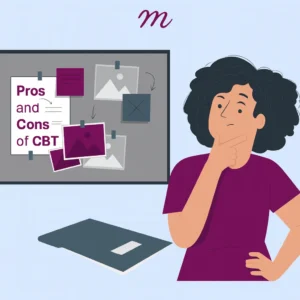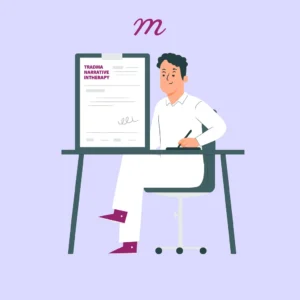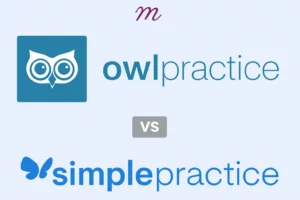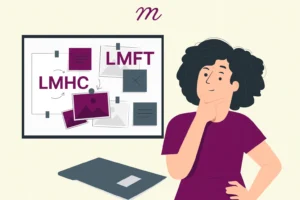The online disinhibition effect is a psychological effect whereby people are more honest, frank, or passionate about themselves within online communities than they would be face-to-face. Therapeutically, this is expressed when clients are surprisingly relaxed sharing confidential, even intimate information within the first phases of the relationship, or when they email emotionally charged messages between sessions that they may never have uttered aloud in your physical office.
If you’ve been practicing online therapy for any length of time, there’s probably a good chance you’ve had a client who shared something very vulnerable within the first couple of minutes of a session, or even in an initial message before the two of you had ever met in real life. You might have reacted, “Wow, that came quick,” or “I didn’t expect that level of vulnerability this early on.” That’s the disinhibition effect in action.
With clients in online therapy, they can reveal more, sooner, and perhaps with less filtering of affect than they may in a more conventional face-to-face setting. While this can be very rewarding and create a sense of deep connection, it can also challenge our presuppositions about pacing, containment, and boundaries.
In this article, we are going to analyze what the disinhibition effect is, why it happens, and how we therapists can treat it with care, openness, and empathy.
What is the Disinhibition Effect?
Disinhibition has nothing to do with manipulation or attention-seeking. Most often, it is the opposite. The disinhibition effect can tear down internal barriers that have muzzled a client or kept them secretive for decades. They may feel safer, less self-conscious, or even anonymous, despite the fact that they’re speaking to you over video and their name is on the screen.
Why Does Online Disinhibition Effect Happen?
The digital space creates a kind of psychological distance. Even if we’re looking each other in the eye over Zoom, something about that screen buffer shifts the way people regulate their expression.
Here are some of the core factors behind this shift:
Anonymity or Sense of Distance: The screen, even in video-based sessions, can make one feel less noticed or “put on display.” It can deaden the inner voice that would otherwise shut them up.
Asynchronicity: For those practicing messaging therapy or email correspondence, the lack of face-to-face conversation can be a sensation of freedom. They have the ability to converse uninterrupted, unrestrained, and free from your facial feedback—though this can also lead to unguarded emotional disclosures.
Less Social Cues: Clients are not picking up on our subtle facial expressions, tone shifts, or eye contact in the same way in online spaces. This can lead to the illusion of a “safer” space in which vulnerability is not quite so risky.
Disinhibition Via Dissociation: The online space can sometimes make everything feel less grounded or more dreamlike, and clients can speak without actually feeling the weight of what they are saying.
These factors don’t affect all clients equally, but they can occur in intense ways, particularly with clients who have shame, social anxiety, or trauma histories.
When Disinhibition is Helpful?
Not all disinhibition is negative, it can be a beautiful therapeutic instrument of bonding. For certain clients, especially those who have spent years biting their tongue or fearing judgment, the online space is the first time they’ve ever felt safe enough to talk about the hard stuff.
This can take the form of:
A trauma survivor child being able to finally call what happened, as the screen allows ample distance to remove panic.
A socially phobic client being able to talk more freely because they’re in the comfort of their home instead of struggling with the waiting room or social cues.
An explorer of gender identity or sexual orientation feeling less exposed providing information online than within the face-to-face awareness of another.
The emotional safety that comes with this feeling of distance can establish trust and genuineness. It can accelerate rapport, enhance insight, and give you a more distinct sense of what’s hidden below the surface.
When Disinhibition is Risky?
Of course, with greater openness comes the risk of emotional dysregulation or even rupture, on both the client’s part and for the relationship as a whole. Some of the typical issues are:
Too Much Too Soon: The client might disclose overwhelming traumas, suicidal tendencies, or confidential secrets before they know how to incorporate them in a positive manner.
Emotional Whiplash: They can feel vulnerable or ashamed after sharing too much too soon and end up experiencing shame, withdrawal, or avoidance of future sessions.
Boundary Issues: The online world can confuse the therapy-real life boundary. Clients will text you between sessions expecting emotional work or care without knowing they’re crossing a boundary.
Projection and Reactivity: Clients will tell you things they wouldn’t in person, anger, flirting, or helplessness, then expect an equivalent response from you or “fix it” in the moment.
These are not ethical failures. They’re signals that a client is experiencing the authentic dilemma of wanting to join and being afraid of being vulnerable. Our job is to help with holding on to that tension, not suppressing it, but helping to contain and work with it.
How to Work with Disinhibition Compassionately?
Operating the disinhibition effect is as much a function of our own awareness and boundaries as it is clinical skill. Following are a few strategies that will allow you to engage clients where they are without burning out or losing therapeutic traction.
1. Acknowledge and Normalize
Shine the disinhibition effect into the light. If a client jumps into something profound or unexpected, you can say:
“At times it is simpler to become open through online meetings than maybe it might be in a face-to-face setting. I wish to ensure we allow ourselves time and see how you’re feeling after opening up like that.”
This requests name the dynamic with acceptance and provides for pacing collaboration.
2. Observe the Emotional Pacing
Just because the client is willing to speak doesn’t mean they’re ready to process . Pay attention to whether disclosures are being taken in by their body and nervous system. Offer regulation strategies and then check in with, “Was that okay to speak out loud?” or “How do you feel in your body right now?”
3. Create Communication Boundaries Early
Set kind but clear boundaries around your availability and the limits of messaging. For example:
“I want you to know that I read what you send between sessions, but I may not always be able to respond right away. Let’s make sure to save the big emotional labor for our time together.”
This frames your role as consistent and containing, rather than constantly available.
4. Use Disclosures as a Window
Rather than viewing disinhibition as disruption, view it as information. What are the reoccurring themes in the client’s emotional life? What are they saying they are not getting that they need—attachment, safety, control? What are you observing as habits of the moment?
5. Take Care of You, Too
Therapists are not immune to the emotional blow of ingesting concentrated, uncooked material—especially when coming all at once through text or evening email. Notice your own nervous system. Are you bracing for client messages? Resentful after session? That is your cue to pace yourself, get supervision, and re-center.
Key Takeaways
The disinhibition effect is not a flaw in online therapy—it’s one of the more nuanced online behavior we see in virtual therapy. It can produce openness, honesty, and true connection. Our work as therapists is not to keep clients from sharing too much, it’s to notice when they do, to figure out what’s motivating it, and to help them work through it in a way that’s safe and supportive. Often, what looks like oversharing is really a desire to be seen, to be held, and to feel less alone, and even through a screen, we’re still deeply capable of offering that.
References
Wu, B., Xiao, Y., Zhou, L., Li, F., & Liu, M. (2023). Why individuals with psychopathy and moral disengagement are more likely to engage in online trolling? The online disinhibition effect. Journal of Psychopathology and Behavioral Assessment, 45(2), 322-332.
Ding, J. L., Lin, Y., & Chen, I. H. (2025). Why individuals with trait anger and revenge motivation are more likely to engage in cyberbullying perpetration? The online disinhibition effect. Frontiers in Public Health, 13, 1496965.
Nesmith, A. (2023). Text-Based Crisis Counseling: An Examination of Timing, Pace, Asychronicity and Disinhibition. Youth, 3(1), 233-245.
Merchant, J. (2021). Working online due to the COVID‐19 pandemic: A research and literature review. Journal of Analytical Psychology, 66(3), 484-505.
Cameron, E. (2022). Online integrative arts psychotherapy. In Integrative Arts Psychotherapy (pp. 129-140). Routledge.







